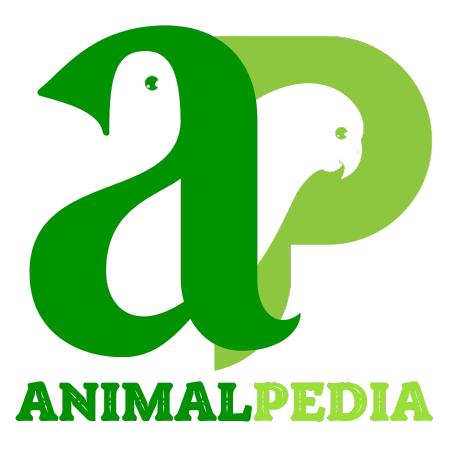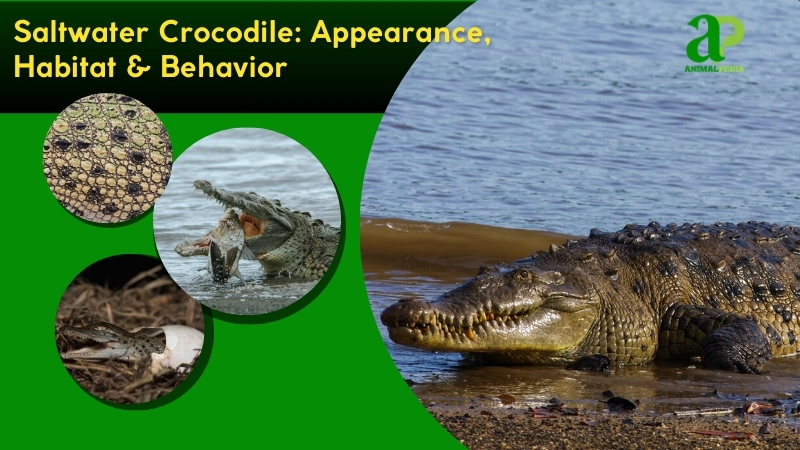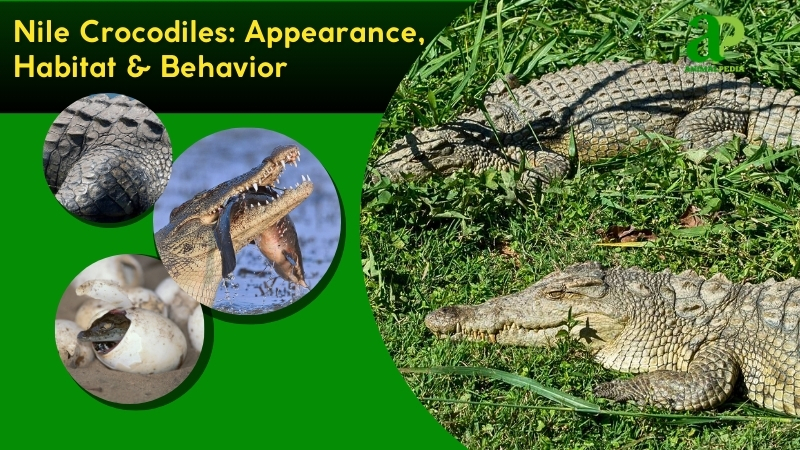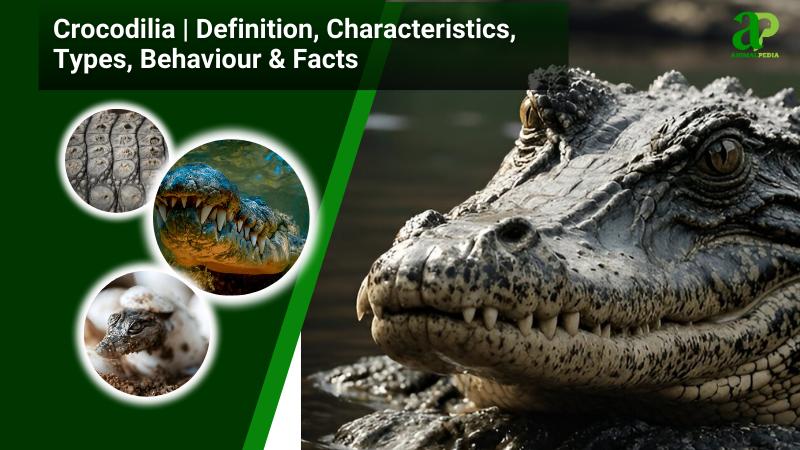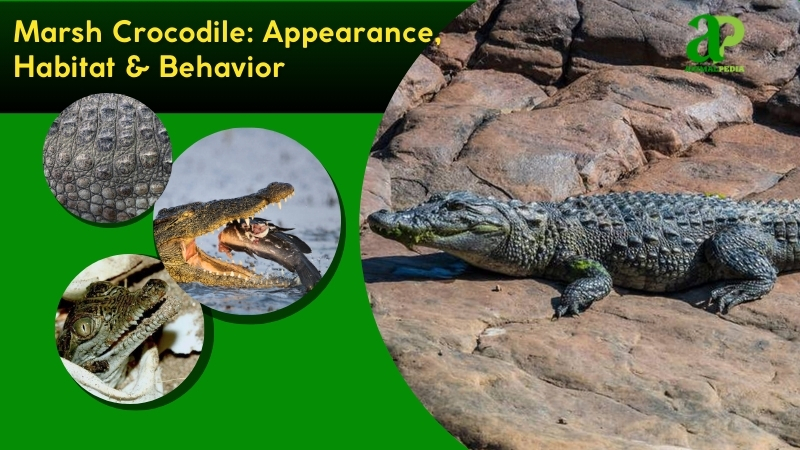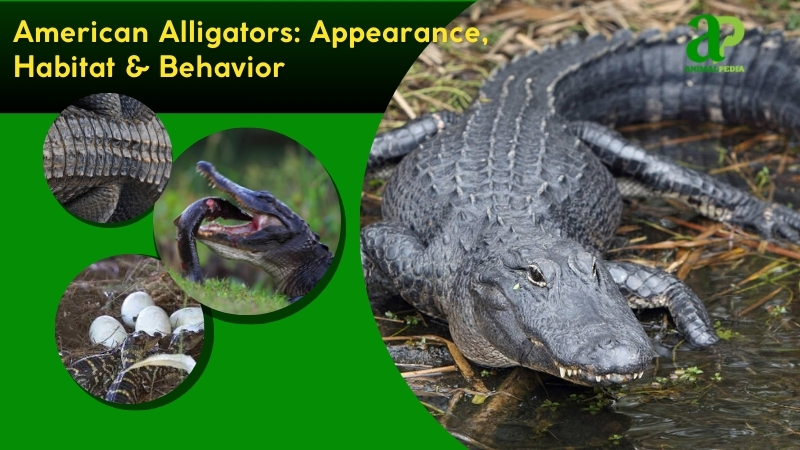Cuban crocodiles captivate with their striking appearance and scarcity. Only one species exists: Crocodylus rhombifer, the Cuban crocodile. A mere 3,000 to 5,000 mature individuals survive in the wild, placing them on the brink of extinction and classifying them as critically endangered.
Their bold coloration—dark green with yellow speckles—and rugged, pebbled scales make them distinctive. These reptiles inhabit only Cuba, restricted to the Zapata Swamp and Isla de la Juventud. Adults typically reach 6.9 to 7.5 feet, though large males can grow to 11 feet and weigh over 474 pounds.
As apex predators, Cuban crocodiles dominate their ecosystems. They display pack-hunting behavior, rare among crocodilians, and pursue prey such as fish, turtles, and small mammals. Their blunt posterior teeth crush turtle shells efficiently, demonstrating dietary specialization. On land, powerful legs enable galloping—a unique hunting advantage. Humans encounter them uncommonly due to isolated habitats, but their aggression stands out, with one documented fatal attack in 1995.
Breeding season begins in May and peaks through July. Females deposit 30 to 40 eggs in mound nests, sometimes excavating holes based on environmental conditions. Incubation spans 58-70 days, with temperature determining hatchling sex—males develop at 30–32°C. Juveniles consume invertebrates and small fish, reaching maturity in 5 to 7 years. Their lifespan extends 50 to 75 years in natural settings.
This article examines the Cuban crocodile’s morphology, range, and behavior. It explores their ecological significance, hunting prowess, and reproductive patterns, providing a focused yet thorough examination of this terrestrial predator.
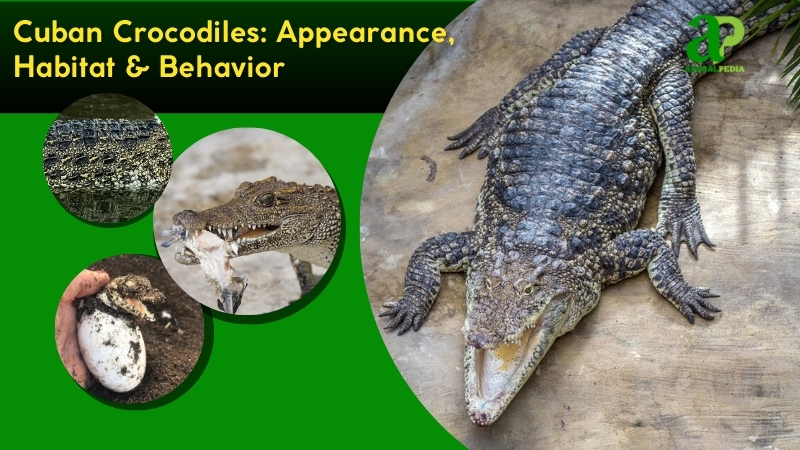
What do the Cuban crocodiles look like?
Cuban crocodiles have robust, compact bodies, typically measuring 6.9–7.5 feet (2.1–2.3 meters) long. Their skin is dark green, with yellow patches that fade as they age. Tough, pebbled scales create a rugged texture, providing protection in Cuba’s swamps.
These features of reptiles include a broad, short snout with sharp teeth and small, elevated eyes for water surveillance. A thick neck connects to a muscular body supported by strong, stocky limbs with webbed claws. Their powerful tails propel them through water efficiently.
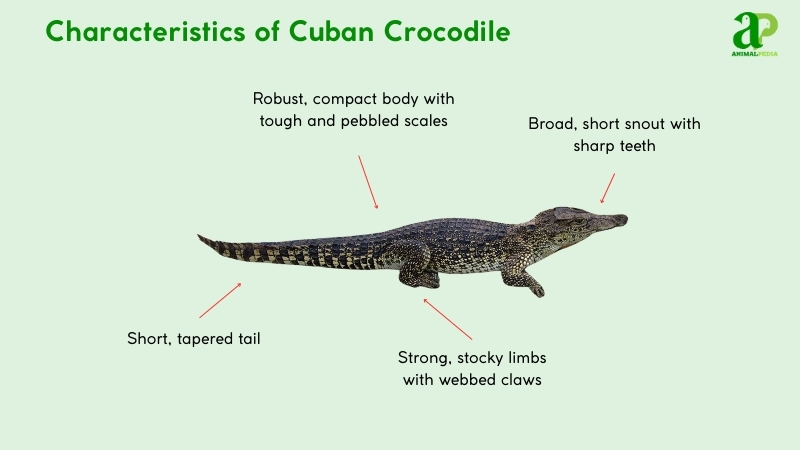
How big do Cuban crocodiles get?
Cuban crocodiles average 6.9–7.5 feet (2.1–2.3 meters) in length and weigh 154–176 pounds (70–80 kg). Males grow larger than females, a key distinction in this species. Adults typically measure 7.5 feet (2.3 meters) snout-to-tail, with weights reflecting their muscular build. These dimensions place them among the smaller crocodilians, yet their terrestrial agility compensates.
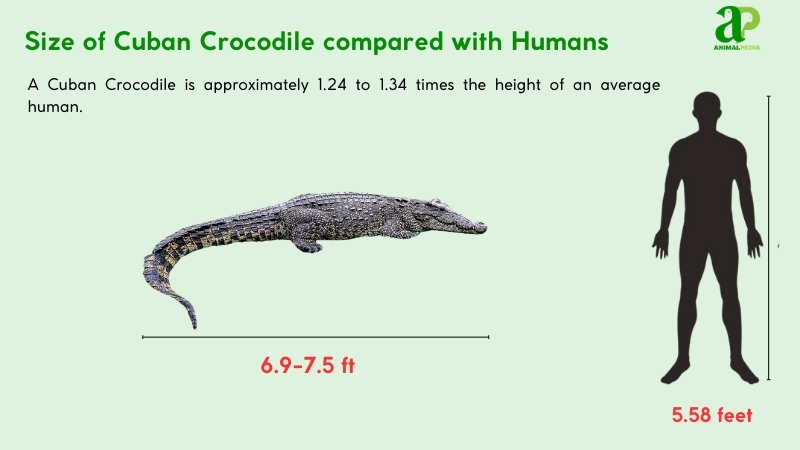
The largest recorded specimen stretched 11 feet (3.5 meters) and weighed 474 pounds (215 kg), discovered in the Zapata Swamp, Cuba, according to research by Milián-García et al. (2015).
Males are 1.6–3.3 feet (0.5–1 meter) taller than females and weigh 110–220 pounds (50–100 kg), demonstrating sexual dimorphism. Below is a table that highlights these differences.
| Trait | Male | Female |
| Length | 7.5–11 ft (2.3–3.5 m) | 6.9–7.5 ft (2.1–2.3 m) |
| Weight | 176–474 lb (80–215 kg) | 154–176 lb (70–80 kg) |
What are the unique physical characteristics of the Cuban Crocodiles?
Cuban crocodiles possess unique traits unmatched among crocodilians. Their ability to gallop on land, powered by unusually strong, stocky limbs, sets them apart. They exhibit a vivid dark green color with yellow speckles that fade as they age. Their blunt, short snout—packed with robust teeth—and heavily armored, pebbled scales (osteoderms) enhance terrestrial capability. These characteristics distinguish them from water-focused relatives, such as the American crocodile (Crocodylus acutus).
Research by Weaver and Densmore (2023) highlights their exceptional limb morphology, enabling bursts of speed up to 5.6 mph (9 km/h). The osteoderms, more pronounced than in most crocodilians, provide structural rigidity for terrestrial locomotion, an uncommon trait in the family. Milián-García et al. (2015) note that the snout’s unique shape aids in crushing turtle shells, a dietary specialization. This compact predator, averaging 6.9–7.5 feet (2.1–2.3 meters), combines agility and armor, making it a distinctive species in Cuba’s Zapata Swamp and Isla de la Juventud.
How do Cuban crocodiles sense their environment with its unique features?
Cuban crocodiles leverage their blunt snouts and strong limbs to thrive in Cuba’s swamps. The snout, packed with sensory receptors, detects prey vibrations, ensuring survival as ambush predators. Their terrestrial galloping—unique among crocodilians—allows them to chase prey on land, enabling them to adapt to both aquatic and dry habitats.
High-set eyes spot prey above water, sharpening hunting precision. Sensitive ears catch low-frequency sounds, aiding threat detection. Tough, pebbled skin shields them from rough terrain, enhancing durability. A keen sense of smell helps track prey over long distances, boosting foraging success. These traits, detailed in Weaver and Densmore (2023), help them master their environment.
Anatomy
Cuban crocodiles are among the most evolutionarily specialized reptiles, exhibiting anatomical adaptations that support their survival in dynamic wetland ecosystems. These physiological systems work in concert to enhance their predatory prowess, endurance, and environmental tolerance.
- Respiratory System: Lungs with unidirectional airflow maximize oxygen intake. A muscular diaphragm aids efficient breathing, supporting prolonged submersion during hunts (Padian & Farmer, 2020).
- Circulatory System: A four-chambered heart separates oxygenated blood, boosting stamina. Valves regulate flow, optimizing energy for terrestrial galloping and aquatic pursuits (Weaver & Densmore, 2023).
- Digestive System: Strong jaws and blunt teeth crush prey, such as turtles. A robust stomach digests bones, while a slow metabolism sustains long fasting periods in swamps.
- Excretory System: Kidneys filter waste efficiently, conserving water in brackish habitats. Salt glands near the tongue excrete excess salt, aiding osmoregulation in Cuba’s wetlands.
- Nervous System: A keen brain processes sensory input from high-set eyes and vibration-sensitive snouts. Enhanced reflexes drive pack-hunting precision and rapid environmental responses.
Their survival reflects a balance between ancient lineage and modern adaptation—one that conservationists strive to protect amid habitat loss and climate change.
Where do Cuban crocodiles live?
Cuban crocodiles live exclusively in western Cuba. They inhabit two key regions: the Zapata Swamp in Matanzas Province and the Lanier Swamp on Isla de la Juventud. These isolated freshwater wetlands are their only natural habitat. The Zapata ecosystem spans 4,520 km² and supports approximately 3,000–5,000 specimens. Their habitat features brackish marshes with dense vegetation.
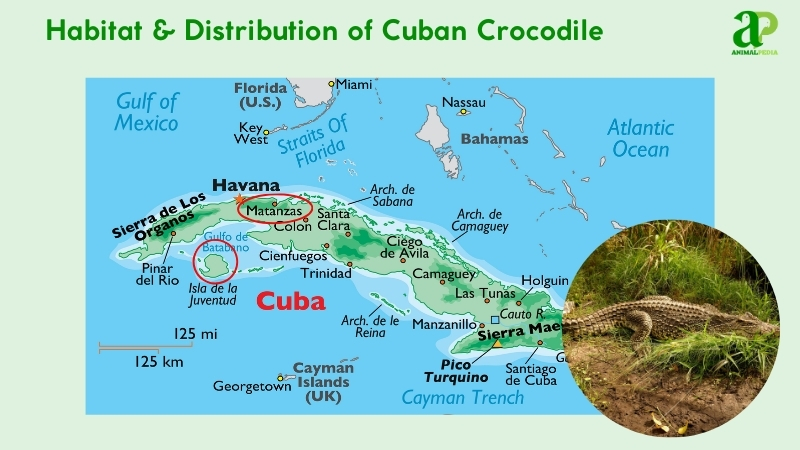
Their environment perfectly matches their biological needs. These endemic reptiles thrive in warm, humid swamps with temperatures between 26 and 30 30°C. They hunt abundant prey, including fish, turtles, and small mammals, using ambush tactics. Their specialized keratinized scales and powerful limbs are adaptations for navigating both muddy waters and terrestrial zones. Weaver and Densmore (2023) document their continuous presence in these habitats for millennia, with no significant migration patterns.
Geographic isolation drives their endemism and unique traits. Fossil evidence and genomic analysis by Milián-García et al. (2015) confirm their long-term evolutionary adaptation to Cuba’s distinctive hydrological systems. Their restricted range makes them a classic example of island specialization among Crocodylidae.
How do seasonal changes affect their behavior?
Cuban crocodiles exhibit distinct behavioral and ecological adaptations that align with Cuba’s seasonal climate. Their activity patterns shift in response to wet and dry cycles, ensuring efficient feeding, breeding, and energy use throughout the year.
- Wet Season (May–October): Heavy rains flood habitats, boosting prey availability. Crocodiles hunt actively, using pack tactics, and mate, with females laying eggs by July.
- Dry Season (November–April): Water recedes, concentrating prey in pools. They ambush more, conserve energy, and guard nests—hatchlings emerge late dry season.
These seasonal adjustments, observed by Ramos-Targarona (2016), reflect the species’ deep synchronization with hydrologic rhythms. Such behavioral plasticity is key to their persistence in fluctuating wetland ecosystems.
What is the behavior of Cuban crocodiles?
Cuban crocodiles display a blend of behavioral traits that reflect both their evolutionary heritage and specialized niche. Endemic to Cuba’s Zapata and Lanier swamps, they are among the most terrestrial of all crocodilian species, exhibiting bold, complex patterns of behavior.
- Feeding Habits: They hunt fish, turtles, and mammals, using blunt teeth to crush shells. Pack-hunting sets them apart.
- Bite & Venomous: Their bite delivers crushing force, not venom. Jaws snap with precision, aided by sensory snouts.
- Daily Routines: Active at dusk, they bask by day. Movements peak during wet seasons.
- Locomotion: Galloping on land reaches 5.6 mph (9 km/h). In water, tails propel swift ambushes.
- Social Structures: Rare cooperative hunting occurs. They defend territories fiercely.
- Communication: Low growls and head slaps signal dominance. Vocalizations coordinate group efforts.
Together, these behaviors showcase Cuban crocodiles’ status as a highly adaptive predator. Their mix of physical power, social complexity, and environmental awareness underscores their critical role in Cuba’s swamp ecosystems.
What do Cuban crocodiles eat?
Cuban crocodiles are strict carnivores, feeding on fish, turtles, and small mammals such as hutias. Turtles top their menu, crushed by blunt rear teeth. They rarely attack humans—one fatal incident in 1995—but aggression spikes near nests. They tear prey into chunks with powerful jaws, swallowing smaller bites whole. Large prey risks gut rupture, though slow digestion copes.
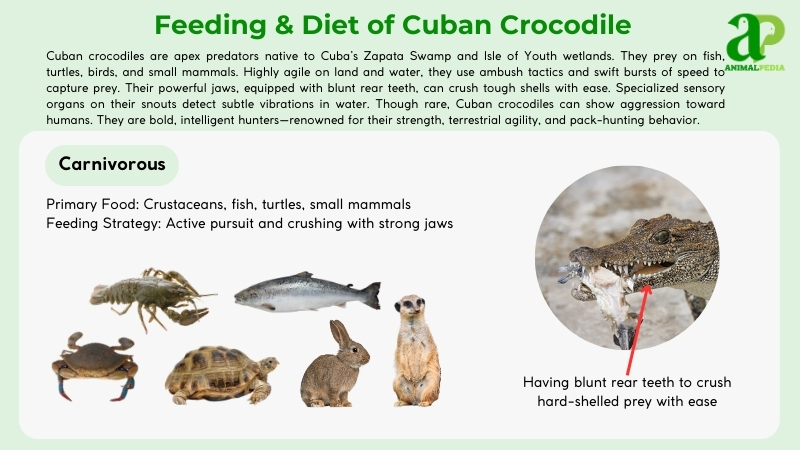
- Diet by Age:
Cuban crocodiles show clear dietary shifts as they mature. Hatchlings primarily feed on insects and small fish, taking advantage of their size and agility. As juveniles, their diet expands to include larger fish and crustaceans. Adults develop the strength and jaw power to hunt more robust prey, such as turtles—crushed with specialized rear teeth—and small mammals like hutias.
- Diet by Gender:
Both male and female Cuban crocodiles exhibit similar feeding behaviors and dietary preferences. There are no major sex-based differences in their diet. Regardless of gender, younger individuals rely more on solitary ambush tactics, while adults, particularly during abundant seasons, may use pack-hunting strategies.
- Diet by Seasons:
Seasonal changes significantly influence feeding habits. During the wet season (May to October), heavy rainfall increases the availability of aquatic prey, leading to a diet rich in fish and other water-dwelling organisms. In the dry season (November to April), as water bodies shrink, prey becomes more concentrated in small pools, prompting crocodiles to shift to ambush hunting of clustered prey such as turtles and small terrestrial animals.
How do Cuban crocodiles hunt their prey?
Cuban crocodiles are adept hunters, using a combination of skill and strategy to catch a variety of prey. With strong jaws and quick reflexes, these predators rely on their sharp senses to detect potential meals. They often lurk underwater, almost invisible to their unsuspecting targets, before striking swiftly to seize and drag them under for consumption. Their hunting prowess showcases their position as top predators in their environment.
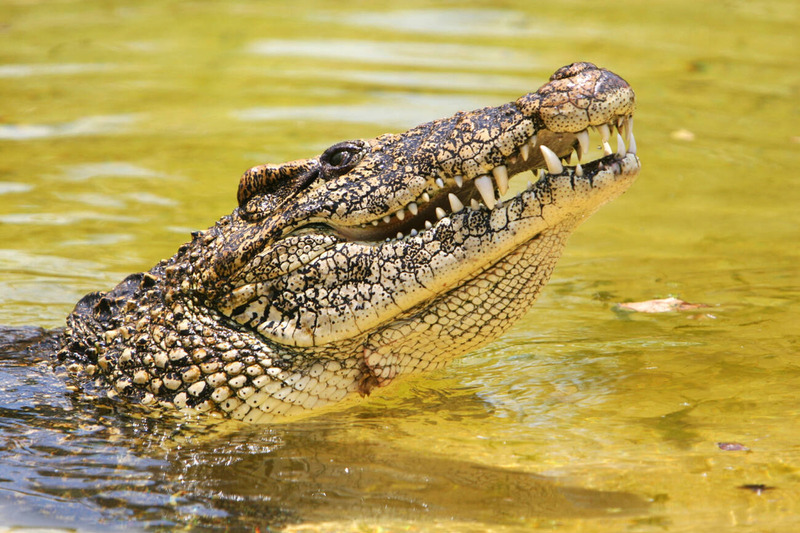
By patiently waiting and executing calculated attacks, Cuban crocodiles outwit their prey, showcasing their intelligence and adaptability. Observing these majestic creatures in action highlights the intricate balance of nature and the importance of preserving all species within the ecosystem.
Through their efficient hunting techniques tailored to diverse environments and prey, Cuban crocodiles exemplify nature’s intricacies and the significance of maintaining ecological harmony.
Are Cuban crocodiles venomous?
Cuban crocodiles don’t possess venom; they rely instead on their strong jaws and hunting skills to capture prey. These creatures stand out as apex predators in their environments, using their agility and stealth to ambush unsuspecting animals near the water. Their ability to propel themselves out of the water enables swift, coordinated attacks, showcasing their prowess as formidable hunters.
When hunting, Cuban crocodiles exhibit patient, strategic behavior. They patiently wait for the ideal moment to strike, ensuring a successful catch. Once they target their prey, they propel themselves with impressive speed, utilizing their sharp teeth to secure their meal.
Despite lacking venom, Cuban crocodiles excel as efficient predators thanks to their hunting techniques and adaptability to diverse environments. Observing these impressive creatures in the wild provides valuable insights into their behavior and survival strategies. Stay tuned to learn more about their activity patterns in the wild!
When are Cuban crocodiles most active during the day?
Cuban crocodiles show peak activity in the early morning and late afternoon when temperatures cool. This thermoregulatory behavior conserves energy during midday heat. Mornings begin with basking behavior as they absorb solar radiation to raise body temperature. Their activity levels gradually increase throughout the day.
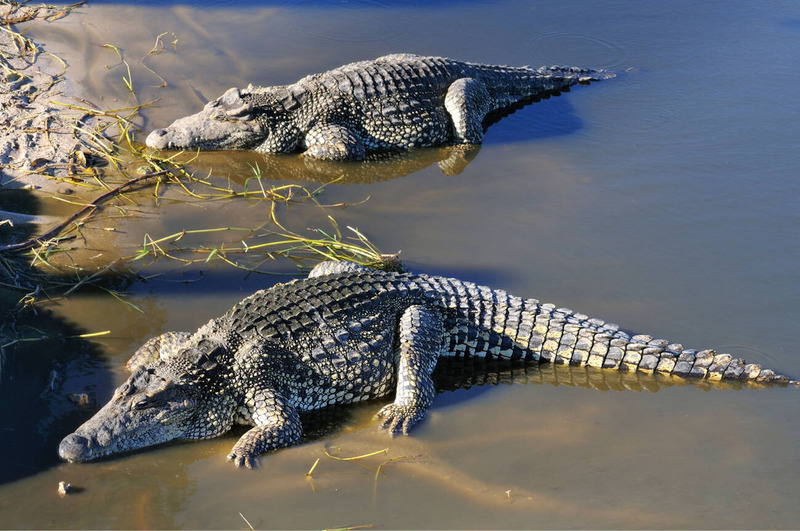
These reptilian predators display aquatic locomotion, using water bodies both for temperature regulation and hunting. As crepuscular hunters, they efficiently utilize these cooler periods for active foraging.
By evening, their metabolic rates decrease and they seek secure nocturnal refuges, typically near water margins or in vegetation.
The diurnal patterns of Cuban crocodiles (Crocodylus rhombifer) demonstrate their evolutionary adaptation to the tropical climate of their native Cuban wetland habitats.
How do Cuban crocodiles move on land and water?
Cuban crocodiles exhibit distinct locomotion patterns across environments. On land, they employ a high walk using their muscular limbs, raising their bodies off the ground—a behavior called the “galloping gait” that can reach speeds of 11 mph. This terrestrial mobility distinguishes them from other crocodilian species.
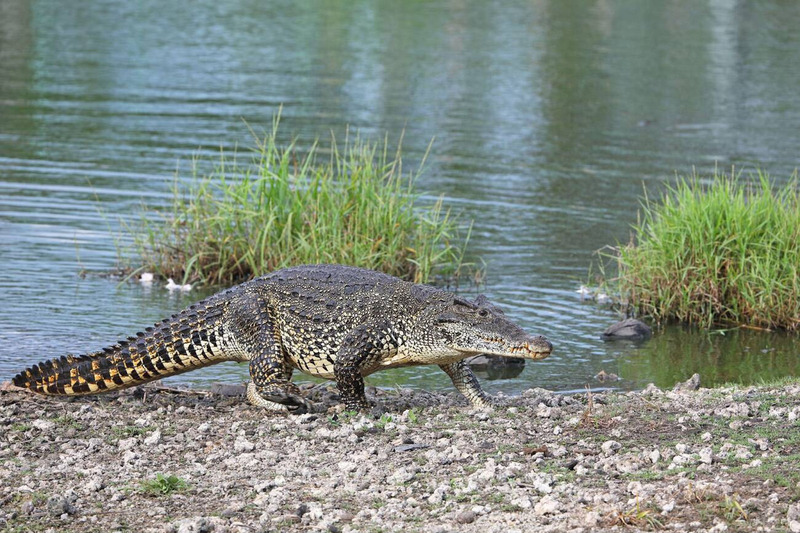
In aquatic settings, Cuban crocodiles use lateral undulation of their powerful, laterally compressed tails as their primary means of propulsion. Their webbed hind feet provide additional thrust and steering capability during underwater navigation. The buoyancy control they demonstrate allows efficient movement between the surface and the depths.
These endemic reptiles transition seamlessly between habitats thanks to physiological adaptations, including powerful leg muscles and hydrodynamic body structure. Their movement patterns reflect evolutionary specialization for the wetland ecosystems of the Zapata Swamp and Isle of Youth in Cuba, their native range.
Do Cuban crocodiles live alone or in groups?
Cuban crocodiles live alone in their habitat. They establish territories and avoid other crocodiles. These reptiles prefer independence, patrolling their domains solo while basking or hunting. They move through marshes with stealth, maintaining their solitary existence.
Unlike social animals, Cuban crocodiles thrive independently. They are self-sufficient predators that navigate wetlands with precise movements. Field observations consistently show these crocodiles operating alone, utilizing the full range of their habitat without social constraints.
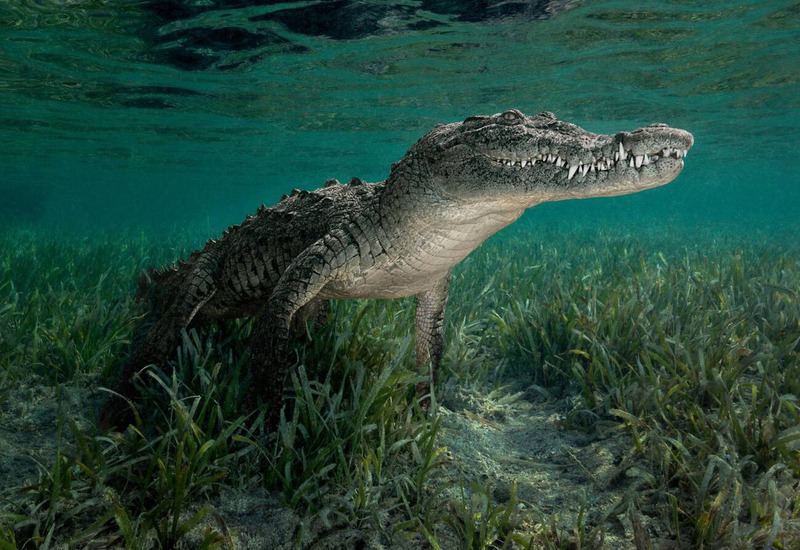
The solitary behavior of Crocodylus rhombifer represents an evolutionary adaptation. Their independence allows optimal resource utilization in their limited range within Cuba’s Zapata Swamp and Isle of Youth.
“The solitary nature of Cuban crocodiles reflects their ecological niche as apex predators. This behavior maximizes hunting efficiency and reduces competition,” notes crocodilian researcher Dr. Manuel Alonso.
How do Cuban crocodiles communicate with each other?
Cuban crocodiles use a combination of vocalizations and body language to communicate with one another. They make hissing, grunting, and low-frequency bellowing sounds to convey information, such as marking territory, showing dominance, and attracting mates. These vocalizations play a crucial role in their social interactions and survival strategies in the wild.
Aside from vocalizations, Cuban crocodiles also use body language to communicate. They demonstrate dominance or aggression by opening their mouths wide, slapping their tails against the water, or engaging in other aggressive displays.
Conversely, submissive behaviors such as lowering their bodies and avoiding eye contact indicate deference and a desire to avoid conflict with other crocodiles.
Observing how Cuban crocodiles communicate offers valuable insights into their behaviors and social dynamics. Their ability to convey messages effectively through both sound and gesture demonstrates the complexity of their communication and enhances our understanding of these reptiles in their natural environment.
How do Cuban crocodiles reproduce?
Cuban crocodiles reproduce sexually through egg-laying. Mating season begins in May and peaks through July, coinciding with Cuba’s wet season. Males attract mates through bellowing displays and head-slapping on water surfaces. Females respond with growls while circling potential partners. Mating occurs in shallow water and lasts only minutes.
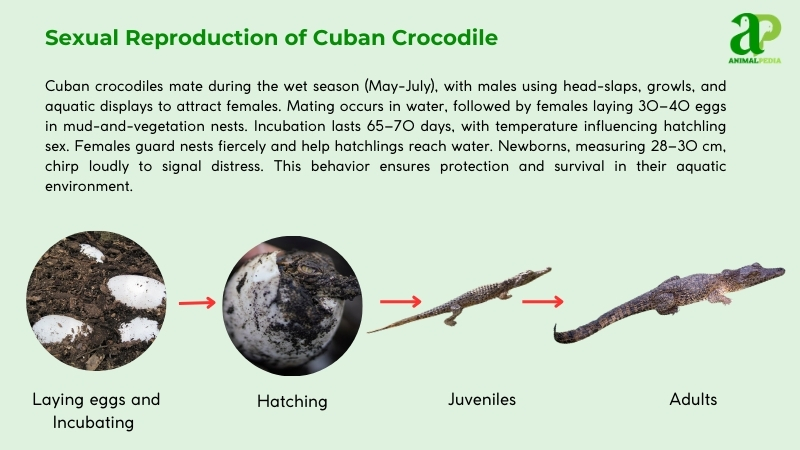
After mating, females deposit 30–40 eggs in nests, each egg weighing 70–80 grams. These nests consist of mud and vegetation mounds or excavated holes near water bodies. Maternal guarding is intense, with females fiercely protecting their clutches while males provide no parental care. Environmental factors like drought or flooding can disrupt laying patterns, as documented in the Zapata Swamp ecosystem in 2018 (Ramos-Targarona, 2016).
Incubation spans 58–70 days at temperatures between 30–32°C. Temperature-dependent sex determination occurs: eggs incubated above 31°C produce males, while those below yield females. Hatchlings measure 25–30 cm (9.8–11.8 in) at birth and consume insects and small fish. Annual growth reaches 10–15 cm (4–6 in), with sexual maturity occurring at 5–7 years.
These reptiles have a lifespan of 50–75 years in optimal conditions. Hybridization with American crocodiles (Crocodylus acutus) threatens the genetic purity of the population, as documented by Milián-García et al. (2015). Conservation efforts are vital for this endangered species.
How long do Cuban crocodiles live?
Cuban crocodiles have an average lifespan of 50 to 75 years in captivity, with slightly shorter lifespans reported in the wild due to environmental stress and predation. Both males and females display similar longevity under managed conditions.
Notably, their lifespan depends on habitat quality, diet, and the absence of human threats. Long-term data from captive breeding programs, such as those reported by Ramos-Targarona et al. (2016), confirm their potential for extended longevity when protected. Their relatively long life supports slow growth and delayed maturity, key traits for species with low reproductive rates and high juvenile mortality.
What are the threats or predators that Cuban crocodiles face today?
Cuban crocodiles confront dire threats: habitat loss, hybridization, and poaching. Predators are few, but humans amplify their peril.
- Habitat Loss: Wetland drainage for agriculture shrinks Zapata Swamp, slashing the range by 50% since 1950. Prey dwindles, starving populations (Ramos-Targarona, 2016).
- Hybridization: Breeding with American crocodiles dilutes genetics. Over 20% of wild individuals show hybrid traits, risking species purity (Milián-García et al., 2015).
- Poaching: Illegal hunting for skin and meat cuts numbers. Annual losses hit dozens, pushing the 3,000–5,000 population closer to collapse.
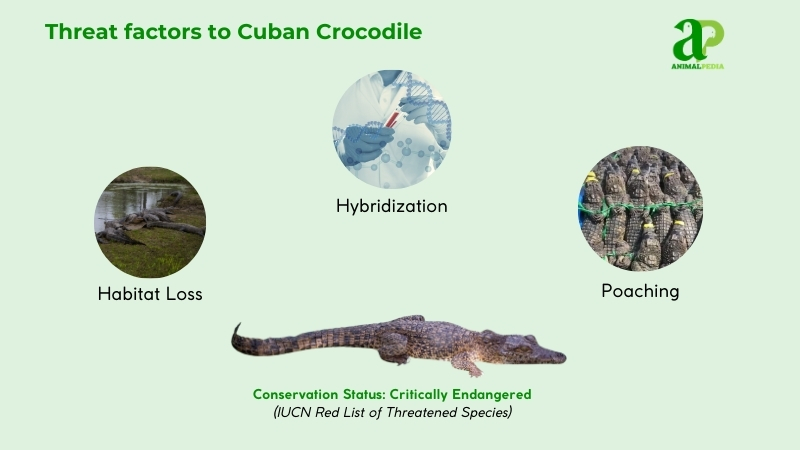
Natural predators barely register. Juveniles face birds like herons and occasional cannibalism from adults, but these pale beside human threats. No apex predator consistently hunts them.
Human impact dominates. Deforestation and tourism in Cuba’s swamps disrupt nesting—40% of nests failed in 2018 due to disturbance. Hybrid zones with C. acutus stem from habitat overlap, worsened by land use. Milián-García et al. (2015) document genetic erosion in Zapata, with 15% hybrid hatchlings in 2014. Conservation lags; only 600 km² of habitat is protected. Without action, extinction looms for this endemic marvel.
Are Cuban crocodiles endangered?
Cuban crocodiles are critically endangered. According to the International Union for Conservation of Nature (IUCN), they are currently classified as Critically Endangered under the Red List Category and Criteria (IUCN SSC Crocodile Specialist Group, 2020). This classification reflects their extremely high risk of extinction in the wild due to habitat loss, hybridization, and illegal hunting.
Today, their wild population is estimated at fewer than 4,000 individuals, with possibly fewer than 1,000 mature breeding adults. They are primarily confined to two restricted habitats in Cuba: the Zapata Swamp and the Lanier Swamp on the Isle of Youth. Habitat encroachment, pollution, and competition with the American crocodile (Crocodylus acutus)—which interbreeds with them—pose significant threats to the species’ genetic integrity and long-term survival.
Ongoing conservation efforts, including captive breeding and habitat protection, aim to stabilize numbers. However, recovery is slow due to their limited range and ecological sensitivity. Long-term survival depends on maintaining pure genetic stock, expanding protected habitats, and mitigating human-crocodile conflict.
What conservation efforts are underway?
Cuban crocodiles benefit from focused conservation work, centered in Cuba’s Zapata Swamp. The Zapata Crocodile Farm, established in the 1960s with Cuban government backing, spearheads breeding and reintroduction initiatives. The Wildlife Conservation Society began collaborating in the 1990s, supporting releases of genetically pure specimens into protected habitats.
Cuba enforces CITES Appendix I regulations, banning wild specimen trade since 2015. Authorities combat illegal hunting through patrols and penalties. Hybridization with American crocodiles (Crocodylus acutus) is a key threat, requiring genetic monitoring to maintain purebred populations.
The Zapata Farm houses 4,000 crocodiles in its captive breeding program. Annual releases of 100-200 hatchlings have achieved survival rates of 60%. International support comes from AZA-accredited zoos, including the Bronx Zoo’s successful breeding program. A 2019 Clark Waldram Fund grant improved incubation facilities to balance sex ratios in hatchlings.
Conservation successes include the 2016 release of 100 juveniles with 70% two-year survival and the 2022 recovery and reintroduction of poached young crocodiles. These efforts unite Cuban scientists with global partners in the fight against the extinction of this endangered endemic species.
Frequently Asked Questions
What makes Cuban crocodiles unique?
Cuban crocodiles are known for their agility and unique behavior. They are one of the few crocodile species that can move easily on land, even running short distances at high speed. They also have a distinctive appearance, with a more slender body and longer legs compared to other crocodiles.
Are Cuban crocodiles aggressive?
Yes, Cuban crocodiles are known to be quite aggressive, especially when defending their territory. They are fast and powerful, using quick bursts of speed to attack prey or deter threats. However, they are not as aggressive toward humans unless provoked.
How do Cuban crocodiles behave in the wild?
Cuban crocodiles are highly territorial and can be aggressive, especially during the breeding season. They are often seen basking in the sun on riverbanks, and they communicate through hissing, growling, and bellowing to defend their territory or attract mates.
How do Cuban crocodiles protect themselves?
Cuban crocodiles rely on their fast reflexes and powerful bite to defend themselves. When threatened, they can quickly escape into the water. They also have tough, armored skin that helps protect them from predators, though adults have few natural enemies.
Do Cuban crocodiles live alone or in groups?
Cuban crocodiles are generally solitary animals, but they sometimes gather in groups, especially during mating season or around abundant food sources. They are territorial and will defend their space from other crocodiles.
